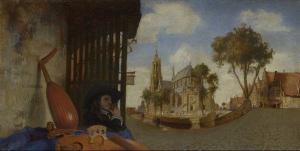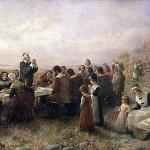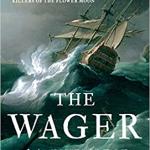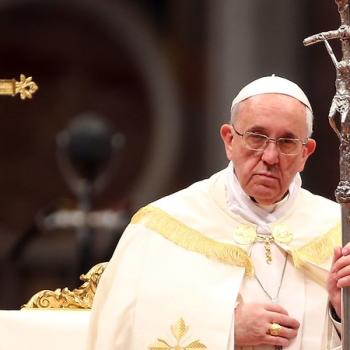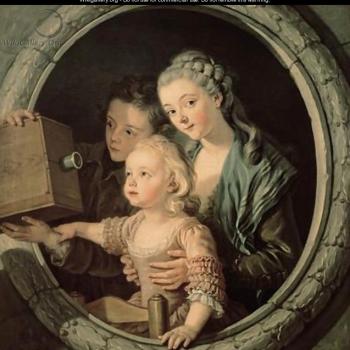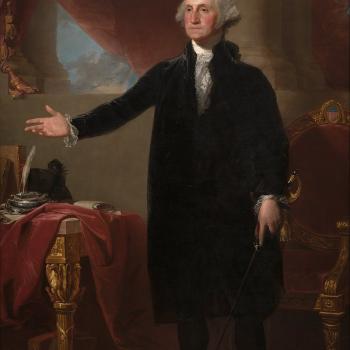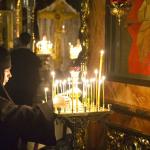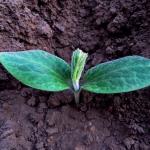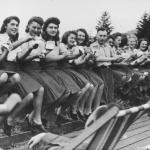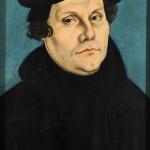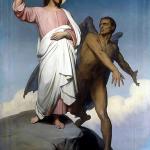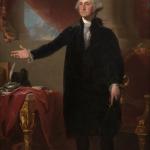Last Time on HOARATS
This Time…
We arrive at a period in history where the Salem Witch Trials occurred along with the discovery of Gravity.
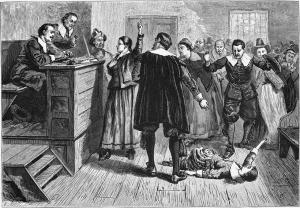
This is where
17th Century
is made.
1650 – 1659
Popes 236 – 242 reigned on the throne of St. Peter.
0 Saint Popes
1 Blessed Pope
5 Non – Sainted Popes
0 Anti – Popes
I, Coriander is a 2005 young adult novel by Sally Gardner, a historical fantasy set in London at the time of the Puritan Commonwealth. The novel traces the time period of the beheading of Charles the 1st through the Restoration of Charles the 2nd. It won the Nestlé Children’s Book Prize Gold Award. It was also shortlisted for the British Children’s Book of the Year and the Stockton Children’s Book of the Year, as well as longlisted for the Carnegie Medal.
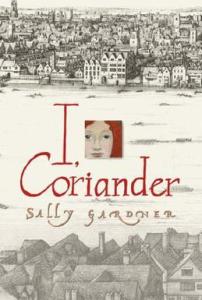
1650’s
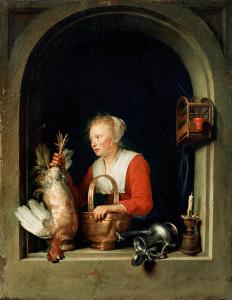
Dou – The Dutch Housewife
I, Juan de Pareja is a novel by American writer Elizabeth Borton de Treviño, which won the Newbery Medal for excellence in American children’s literature in 1966.
The book is based on the Portrait of Juan de Pareja, the real-life portrait that Diego Velázquez made of his slave Juan de Pareja. It is written in the first person as by the title character de Pareja, a half-African slave of Velázquez’s.
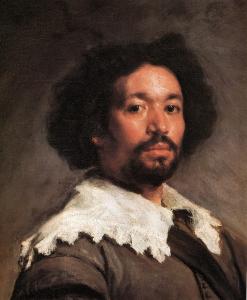
Detail of Velázquez’s Portrait of Juan de Pareja, 1650
1650 – René Descartes, (March 31, 1596 – 11 February 11, 1650) one of the fathers of the Enlightenment, dies in Stockholm.
No doubt you know that Galileo had been convicted not long ago by the Inquisition, and that his opinion on the movement of the Earth had been condemned as heresy. Now I will tell you that all things I explain in my treatise, among which is also that same opinion about the movement of the Earth, all depend on one another, and are based upon certain evident truths. Nevertheless, I will not for the world stand up against the authority of the Church. …I have the desire to live in peace and to continue on the road on which I have started.- Letter to Marin Mersenne (end of Feb., 1634) as quoted by Amir Aczel, Pendulum: Leon Foucault and the Triumph of Science (2003)
1650 – Otto von Guericke (November 30, 1602 – May 21 ,1686) invents the vacuum pump. He was a German scientist, inventor, and politician. He demonstrated the force of air pressure with dramatic experiments.He machined two 20-inch diameter hemispheres and pumped all the air out of them, locking them together with a vacuum seal. The air pressure outside held the halves together so tightly that sixteen horses, eight harnessed to each side of the globe, could not pull the halves apart.
1651: Publication of Thomas Hobbes’s (April 5, 1588 – December 20, 1679) infamous book Leviathan,
“I often observe the absurdity of dreams, but never dream of the absurdity of my waking thoughts.”
― Leviathan
A View of Delft by Carel Fabritius
1653 –
French king Louis XIV (September 5, 1638 – September 1, 1715) liked to use dance as a way of projecting his absolute power. A year before his glorious coronation, he embodied the rising sun – dressed as the sun god, Apollo – in the centre of the planetary system.The Ballet Royal de la Nuit was a huge success and was performed a further six times. The iconic role of the sun god was like a second birth for Louis XIV, who from then on was known by his famous nickname ‘the Sun King’, and the sun henceforth became his favourite symbol. The dancing Sun King – Swiss National Museum – Swiss history blog
1654 – St. Peter Claver (1580–1654), Jesuit priest (Colombia) dies.
“We must speak to them with our hands before we speak to them with our lips.”
- Declared Venerable: N/A
- Beatified: September 21, 1851 by Pope Pius IX
- Canonized: January 15, 1888 by Pope Leo XIII
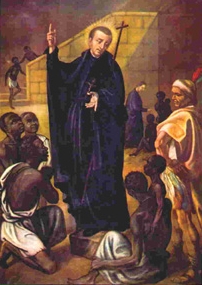
St. Peter Claver was a Spanish Jesuit priest and missionary born in Verdú (Catalonia, Spain) who, due to his life and work, became the patron saint of slaves, the Republic of Colombia, and ministry to African Americans. During the 40 years of his ministry in the New Kingdom of Granada, it is estimated he personally baptized around 300,000 people (in groups of 10) and heard the confessions of over 5,000 slaves per year. He is also patron saint for seafarers. He is considered a heroic example of what should be the Christian praxis of love and of the exercise of human rights.[2] The Congress of the Republic of Colombia declared September 9 as the Human Rights national Day in his honor.
November 23, 1654 –Between 10:30 and 12:30 at night, Blaise Pascal (June 19,1623 – August 19, 1662) had an intense religious experience , his night of fire, and immediately wrote a brief note to himself which began: “Fire. God of Abraham, God of Isaac, God of Jacob, not of the philosophers and the scholars…” and concluded by quoting Psalm 119:16: “I will not forget thy word. Amen.” He seems to have carefully sewn this document into his coat and always transferred it when he changed clothes; a servant discovered it only by chance after his death. This piece is now known as the Memorial.
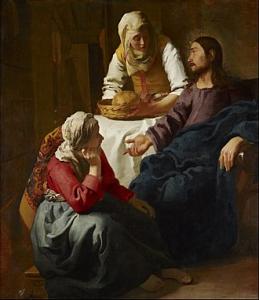
Vermeer – Christ in the House of Martha and Mary
November 3, 1655 – Conversion of Queen Christina of Sweden (December 18, 1626 – April 19, 1689) to Catholicism.
Pope Alexander VII described Christina as “a queen without a realm, a Christian without faith, and a woman without shame.” Notwithstanding, she played a leading part in the theatrical and musical communities and protected many Baroque artists, composers, and musicians.
Christina, who was the guest of five consecutive popes and a symbol of the Counter-Reformation, is one of the few women buried in the Vatican grotto. Her unconventional lifestyle and occasional masculine style of dressing have been featured in countless novels, plays, operas, and film. In most biographies of Christina, her gender and cultural identity play an important role.
July 28, 1655 – Cyrano de Bergerac (March 1619 – July 28, 1655) dies. He was a French novelist, playwright, epistolarian, and duelist. He is best known as the inspiration for Edmond Rostand‘s most noted drama, Cyrano de Bergerac (1897), which, although it includes elements of his life, also contains invention and myth.
1656: Jews return to England after Cromwell repeals the law of 1290 forbidding their residence in the country.
September 3, 1658 – Oliver Cromwell (April 25, 1599 – September 3, 1658) dies. He was an English statesman, politician and soldier, widely regarded as one of the most important figures in the history of the British Isles. Oliver Cromwell is thought to have suffered from malaria and kidney stone disease. In 1658, he was struck by a sudden bout of malarial fever, and spurned the only known treatment, quinine, because it had been discovered by Catholic Jesuit missionaries.
The Bizarre 300 Year Adventure of Oliver Cromwell’s Head – YouTube
1660’s
St. Vincent de Paul, CM (April 24, 1581 –September 27, 1660) dies.
1660: Daniel Defoe (English) (1660 – 24 April 1731) is born. He is the author of Robinson Crusoe (1719) This novel is often credited as marking the beginning of realistic fiction as a literary genre. It is generally seen as a contender for the first English novel.
December 17, 1663: Nzinga Ana de Sousa Mbande (c. 1583 – 17 December 1663) dies. She was a Southwest African ruler who ruled as queen of the Ambundu Kingdoms of Ndongo (1624–1663) and Matamba (1631–1663), located in present-day northern Angola. Born into the ruling family of Ndongo, her father Ngola Kilombo Kia Kasenda was the king of Ndongo.
1663/1664 – “Blessed Jesus, at your word” written by Tobias Clausnitzer in 1663, and also based on a 1664 melody by Johann Rudolph Ahle. English translation by Catherine Winkworth in 1863?
1664–1718: Our Lady of Laus.or Refuge of Sinners denotes Marian apparitions that took place between 1664 and 1718 in Saint-Étienne-le-Laus, France, to Benoîte Rencurel, a young shepherdess. The apparitions were approved by the Holy See on May 5, 2008. Pope Pius IX granted a Canonical Coronation to her marble image on May 23, 1855.
August 27, 1664: Francisco de Zurbarán (baptized November 7, 1598 – 27 August 27, 1664 ) dies. He was a Spanish painter. He is known primarily for his religious paintings depicting monks, nuns, and martyrs, and for his still-lifes. Zurbarán gained the nickname “Spanish Caravaggio“, owing to the forceful use of chiaroscuro in which he excelled.
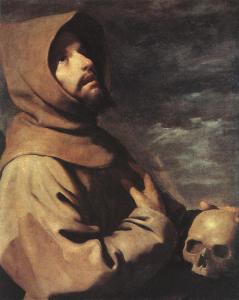
Saint Francis, c. 1658–1664
He was the father of the painter Juan de Zurbarán.
1665–Girl With A Pearl Earring is an oil painting by Dutch Golden Age painter Johannes Vermeer –dated c. 1665. Going by various names over the centuries, it became known by its present title towards the end of the 20th century after the earring worn by the girl portrayed there. The work has been in the collection of the Mauritshuis in The Hague since 1902 and has been the subject of various literary and cinematic treatments.
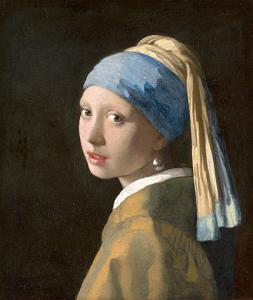
1666 – New Amsterdam is renamed New York by the recently established English regime.
Even old New York was once New Amsterdam
Why they changed it I can’t say
People just liked it better that way
–Istanbul – They Might Be Giants
1667 – John Locke’s (August 29, 1632 – 28 October 28, 1704) A Letter Concerning Toleration is published.
“No peace and security among mankind—let alone common friendship—can ever exist as long as people think that governments get their authority from God and that religion is to be propagated by force of arms.”
― A Letter Concerning Toleration
1667: Paradise Lost by John Milton (December 9, 1608 – November 8, 1674) is published.
1667: The first successful human blood transfusion is achieved in Paris by Jean Baptiste Denis. apparently saving the life of a 15-year-old boy. With the assistance of Paul Emmerez he transfused about twelve ounces of lamb blood into the veins of a 15-year-old boy who had suffered from uncontrollable fevers for two months and had been consequently bled with leeches 20 times by a barber-surgeon, to no effect. After Denys’ intervention, allegedly, by the next morning, the boy was alert, and seemingly cured of his illness.
He performed another transfusion on a middle-aged butcher with pleasing results. The man had not died and was found to be in great spirit. Realistically, both instances of success were most likely due to the small amount of blood that was actually transfused into these people, which did not trigger any major allergic reaction.
November 30, 1667 – Jonathan Swift (Anglo-Irish) (November 30, 1667 – October 19, 1745) is born. He is the author of Gulliver’s Travels (1726).
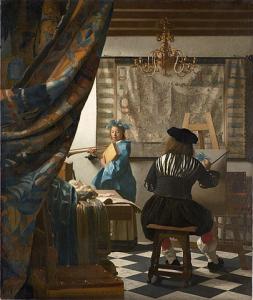
Jan Vermeer – The Art of Painting
1668 – Giambattista Vico is born in Naples, Italy. He is recognised as one of the first Counter-Enlightenment figures in history.
1668 – The Jesuits establish a mission at Sault Sainte Marie which becomes the starting point for French exploration south of the Great Lakes.
1668 – The Bank of Sweden is founded, and survives today as the world’s oldest bank.
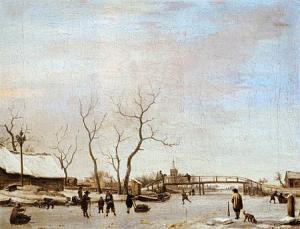
van de Velde – Frozen Canal with Skaters and Hockey Players, Musée du Louvre
1669 – James VII and II (October 14, 1633 – September 16, 1701) the duke of York, heir to the English and Scottish thrones, is secretly received into the Roman Catholic church. James was the King of England and Ireland as James II and King of Scotland as James VII from the death of his elder brother, Charles II, on February 6, 1685. He was deposed in the Glorious Revolution of 1688. He was the last Catholic monarch of England, Scotland and Ireland. His reign is now remembered primarily for conflicts over religious tolerance, but it also involved struggles over the principles of absolutism and the divine right of kings. His deposition ended a century of political and civil strife in England by confirming the primacy of the English Parliament over the Crown.
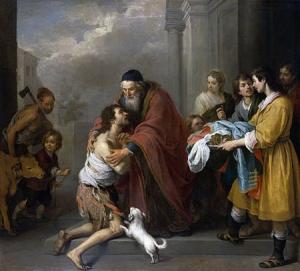
Murillo – Return of the Prodigal Son, National Gallery of Art
1669 – Robert de La Salle (November 22, 1643 – March 19, 1687) makes his first exploration of the Ohio valley, providing the basis for France’s later claim to the area.
1669 – Samuel Pepys was an English diarist and naval administrator. He served as administrator of the Royal Navy and Member of Parliament. He is most famous for the diary he kept for a decade. It is one of the most important primary sources for the English Restoration period. It provides a combination of personal revelation and eyewitness accounts of great events, such as the Great Plague of London, the Second Dutch War, and the Great Fire of London.
1670’s
1670 – Blaise Pascal – Pensées (posthumously published).
“Belief is a wise wager. Granted that faith cannot be proved, what harm will come to you if you gamble on its truth and it proves false? If you gain, you gain all; if you lose, you lose nothing. Wager, then, without hesitation, that He exists.”
― Pensées
1670 – English Benedictine monk Serenus de Cressy publishes a translation of Julian of Norwich‘s Sixteen Revelations on the Love of God (1670). This book might have been lost but for Cressy’s zeal.
1672 – Marie of the Incarnation (Ursuline) (1599–1672) dies.
Pedro Calungsod (July 21, 1654 – April 2, 1672: Aged 17)
Canonized October 21, 2012, St. Peter’s Basilica, Vatican City by Pope Benedict XVI
Feast April 2nd
Pedro Calungsod was was a Catholic Filipino migrant, sacristan and missionary catechist who, along with the Spanish Jesuit missionary Diego Luis de San Vitores, suffered religious persecution and martyrdom in Guam for their missionary work in 1672. He lived at around the same time as Saint Kateri but in a different part of the world. They were canonized on the same day.
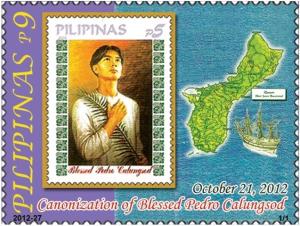
1673 – St. Margaret Mary Alacoque’s vision of the Sacred Heart of Jesus founds one of the most significant Catholic devotions of all time.
1674 – Samuel Sewall begins a diary of daily life in Boston, Massachusetts, that will span a period of more than fifty years.
1674: Shivaji I (c. 19 February 19, 1630 – 3 April 3, 1680) was an Indian ruler and a member of the Bhonsle Maratha clan. Shivaji carved out his own independent kingdom from the declining Adilshahi sultanate of Bijapur that formed the genesis of the Maratha Empire. In 1674, he was formally crowned the Chhatrapati of his realm at Raigad Fort.
April 18, 1676: (ACH Podcast) St. Kateri Tekakwitha (1656 – April 17, 1680) informally known as Lily of the Mohawks was baptized at the age of 19, on Easter Sunday, . Tekakwitha was renamed “Catherine” after St. Catherine of Siena (Kateri was the Mohawk form of the name).
1677 – The Hymn “Fairest Lord Jesus” is written. According to some accounts, it was called “Crusader’s Hymn” because it was sung by German Crusaders as they made their way to the Holy Land. But William Jensen Reynolds dismisses as “completely erroneous” any association of this hymn with the Crusades. The words may have originated in the Jesuit Order, which came into being after the Crusades. The words were first printed in a Münster Gesangbuch of 1677, a Roman Catholic hymnbook.
1677: Baruch Spinoza‘s Ethics, dealing with God, the mind and the emotions, is published shortly after his death.
“It is the part of a wise man, I say, to refresh and restore himself in moderation with pleasant food and drink, with scents, with the beauty of green plants, with decoration, music, sports, the theater, and other things of this kind, which anyone can use without injury to another.”
― Ethics
1678: Pilgrim’s Progress by John Bunyan (November 30, 1628 – August 31, 1688) is published.
1678 – The Popish Plot, an invented Jesuit conspiracy to kill Charles II, results in the execution of about thirty-five Roman Catholics.
March 4, 1678: Antonio Lucio Vivaldi (March 4, 1678 – July 28, 1741) is born. He was an Italian composer, virtuoso violinist and impresario of Baroque music. Along with Johann Sebastian Bach and George Frideric Handel, Vivaldi ranks amongst the greatest Baroque composers and his influence during his lifetime was widespread across Europe, giving origin to many imitators and admirers
1678 – Christiaan Huygens expounds the theory that light consists of a vibration forming a ripple of waves.
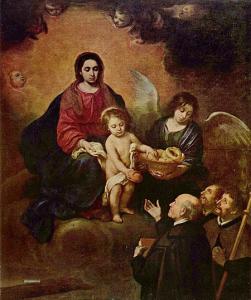
The Christ Child Distributing Bread to Pilgrims (1678) by Bartolomé Esteban Murillo
1680’s
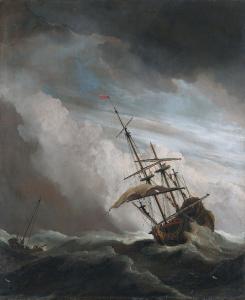
Willem van de Velde the Younger (December 18, 1633 (baptised) – April 6, 1707)
The gust (c. 1680), in the collection of the Rijksmuseum
St. Kateri Tekakwitha informally known as Lily of the Mohawks (1656 – April 17, 1680) dies.
1680 – Edward Teach (c. 1680 – 22 November 1718), better known as Blackbeard was born. He was an English pirate who operated around the West Indies and the eastern coast of Britain’s North American colonies.
1680 – The Pueblo Indians of New Mexico rise against the Spanish, killing 21 missionaries and some 400 colonists.
1680 – Ireland becomes the first European region in which the potato is an important food crop.
1680 – A comet intrigues Edmund Halley, who works out that it has been around before.
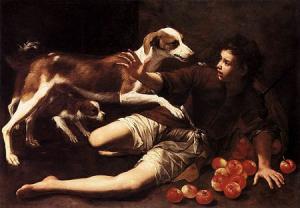
De Villavicencio – Fallen Apple Basket
1681 – The Canal du Midi is completed in France, including at one point a 160-metre tunnel through high ground.
1681 – A professional ballet company in Paris introduces female dancers and the world’s first prima ballerina, Mlle de Lafontaine.
1681 – Charles II grants William Penn the charter for the region that becomes Pennsylvania, in settlement of a debt to Penn’s father
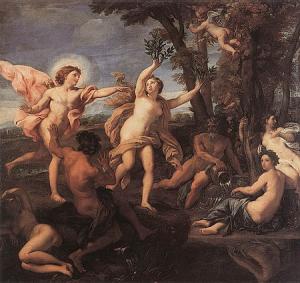
1682 – Publication of Pierre Bayle’s Diverse Thoughts on Halley’s Comet.
1682 – Robert de la Salle travels down the Mississippi to its mouth and claims the entire region for France, naming it Louisiana.
1682 – William Penn approves the Great Law, allowing complete freedom of religious belief in Pennsylvania
1684 – The “Sussex Carol” is a Christmas carol popular in Britain, sometimes referred to by its first line “On Christmas night all Christians sing”. Its words were first published by Luke Wadding, a 17th-century Irish bishop, in a work called Small Garland of Pious and Godly Songs (1684). It is unclear whether Wadding wrote the song or was recording an earlier composition.
1685 – Johann Sebastian Bach is born.
February 1685: George Frideric Handel ( 23 February 23,1685 – 14 April 14,1759) is born.
1686: The Café Procope in the Rue de l’Ancienne Comédie is a café in the 6th arrondissement of Paris. It was opened in 1686 by the Sicilian chef Procopio Cutò ; it became a hub of the Parisian artistic and literary community in 18th and 19th centuries. He introduced the Italian “ice cream” gelato at his café and is one of the first to sell this new European product directly to the public. Prior to then it was reserved for royalty only. Cutò’s café served it in small porcelain bowls that resembled egg cups. He is sometimes referred to as “The Father of Italian gelato”. Marie Antoinette and Napoleon are known to have frequented the restaurant.
1686 – Old St. Mary, Pine Bluff, Arkansas – American Catholic History The earliest Catholic settlement in what is now the state of Arkansas was Arkansas Post, established in 1686 by Henri de Tonti, a lieutenant of the great French explorer Robert Sieur de la Salle.
1687 – Condemnation of Quietism by Pope Innocent XI.
1687 – Newton’s Philosophiae Naturalis Principia Mathematica is published. It expounds Newton’s laws of motion and his law of universal gravitation.
1687 – It wasn’t until the end of the 17th century though that the Jesuits made a significant mark. “Confucius, the Philosopher of the Chinese,” a remarkable work by Jesuits like Philippe Couplet and Prospero Intorcetta, was released in Paris..
March 14, 1687 -(ACH Podcast) Father Kino, SJ (August 10, 1645 – March 15, 1711) begins his mission of exploration and ministry in the region then known as the Pimería Alta, modern-day Sonora in Mexico and southern Arizona in the United States.
The Witch of Blackbird Pond is a children’s novel by American author Elizabeth George Speare, published in 1958. The story takes place in late 17th-century New England. It won the Newbery Medal in 1959.
The Book Starts in April 1687.
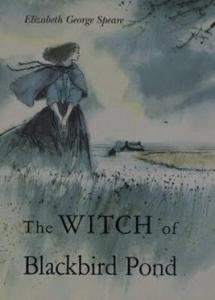
1688 –Pensées is published. In English.
1688 – Aphra Behn’s novel Oroonoko makes an early protest against the inhumanity of the African slave trade.
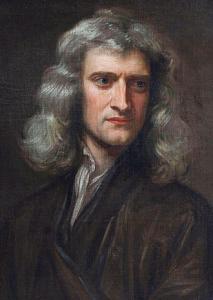
1689 – The 17-year-old Peter the Great becomes co-tsar of Russia with his half-brother Ivan V.
1689 –In the spring the “young gentlewomen” of Josias Priest’s School for Young Ladies in Chelsea gave the only performance of Dido and Aeneas known to have taken place during Purcell’s lifetime.
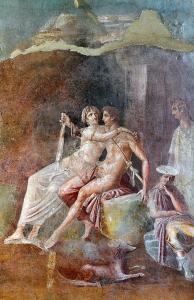
Dido and Aeneas, from a Roman fresco, Pompeian Third Style (10 BC – 45 AD), Pompeii, Italy
April 19, 1689 – Queen Christina (December 18, 1626 – 19 April 19, 1689) dies.
1690’s
1690 – John Locke publishes his Essay concerning Human Understanding, arguing that all knowledge is based on experience.
February 13, 1692 –The Massacre of Glencoe took place in Glen Coe in the Highlands of Scotland . An estimated 30 members and associates of Clan MacDonald of Glencoe were killed by Scottish government forces, allegedly for failing to pledge allegiance to the new monarchs, William III and Mary II.
1692 – The Salem Witch Trials– The Massachusetts town of Salem is gripped by witch-hunting hysteria. Twenty people convicted of witchcraft are hanged in Salem, and one is pressed to death.
How did the idealistic Bay Colony arrive—three generations after its founding—in such a dark place? Nearly as many theories have been advanced to explain the Salem witch trials as the Kennedy assassination. Our first true-crime story has been attributed to generational, sexual, economic, ecclesiastical, and class tensions; regional hostilities imported from England; food poisoning; a hothouse religion in a cold climate; teenage hysteria; fraud, taxes, conspiracy; political instability; trauma induced by Indian attacks; and to witchcraft itself, among the more reasonable theories.
– Stacy Schiff, The Witches: Salem, 1692 (2015) Little, Brown and Company
1692 – Brother Lawrence’s The Practice of the Presence of God is published.
“The difficulties of life do not have to be unbearable. It is the way we look at them – through faith or unbelief – that makes them seem so. We must be convinced that our Father is full of love for us and that He only permits trials to come our way for our own good.
Let us occupy ourselves entirely in knowing God. The more we know Him, the more we will desire to know Him. As love increases with knowledge, the more we know God, the more we will truly love Him. We will learn to love Him equally in times of distress or in times of great joy.”
― The Practice of the Presence of God
1693 – Gold is found in Brazil, launching the first great American gold rush.
November 21, 1694 – Voltaire (November 21, 1694 – May 30, 1778) is born. He wrote the book Candide (1759).
1695 – Giuseppe Domenico Scarlatti (October 26, 1685 – 23 July 23, 1757) known mainly for his 555 keyboard sonatas learned the virtuoso harpsichordist from his famous father Pietro Alessandro Gaspare Scarlatti (May 2, 1660 – October 22, 1725) known for his operas and chamber cantatas. He is considered the most important representative of the Neapolitan school of opera.
July 8, 1695: Christiaan Huygens (April 14, 1629 – 8 July 8, 1695) dies. He was a Dutch mathematician, physicist, engineer, astronomer, and inventor who is regarded as a key figure in the Scientific Revolution.
February 8, 1696– Peter the Great who had jointly reigned since 1682 with his mentally-ill older half-brother, Tsar Ivan V, becomes the sole Tsar of Russia when Ivan dies at the age of 29.
1696 – Fort St William is built by the East India Company in the Ganges delta, and subsequently develops into Calcutta.
1696 – St. Alphonsus Liguori (1696–1787) is born in Naples, Italy.
January 8, 1697 – Thomas Aikenhead is hanged outside Edinburgh, becoming the last person in Great Britain to be executed for blasphemy.
January 11, 1697 – French writer Charles Perrault releases the book Histoires ou contes du temps passé (literally “Tales of Past Times”, known in England as “Mother Goose tales”) in Paris, a collection of popular fairy tales, including Cinderella, Puss in Boots, Red Riding Hood, The Sleeping Beauty and Bluebeard.
March 9 1697 – Grand Embassy of Peter the Great: Tsar Peter the Great of Russia sets out to travel in Europe incognito, as Artilleryman Pjotr Mikhailov. He studies western European technology, working as a ship’s carpenter in Dutch and English shipyards.
1697 – In his opera La Caduta de’ Decemviri, Alessandro Scarlatti introduces a new form of prelude, later known as the Italian overture, which is an important stage in the development of the symphony.
1697 – In the Treaty of Rijswijk, Spain cedes the western half of Hispaniola to France, which names its new colony Saint-Domingue.
1698 – Thomas Savery creates the first practical steam engine, designed to pump water out of mines.
1698 – A maker of harpsichords in Florence, Bartolomeo Cristofori, develops the piano (‘soft’) and forte (‘loud’) feature which leads to the piano.
1699: Locke’s Second Treatise of Government is published.
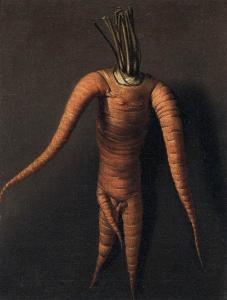
Willem Frederiksz van Royen – The Carrot
Next Time on
HOARATS
To Understand
What I love and How I Write About History
Hit the Link Above.
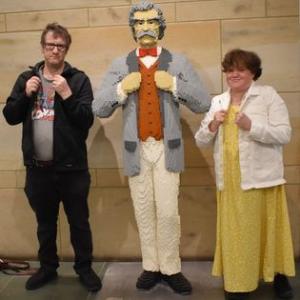
To understand about this particular series I’m writing about, please read
The Catholic Bard’s Guide To History Introduction
And to view a historical article click on


